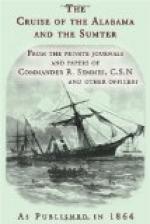Captain Semmes asserts that shots were fired at the Alabama after the signal of surrender. We will not attempt to substantiate a charge like this: but French officers maintain it to be an undeniable fact that, after the Confederate flag had been lowered, the Kearsarge fired no less than five shots into her. We believe that Captain Winslow does not deny the charge; but asserts that he was unaware of the act of surrender. In his letter to the Daily News, he declares the accusation that he had been guilty of this act to be “twaddle” (we quote his own phrase).
The master’s mate of the Alabama, Mr. Fullam, was despatched in the dingey to the Kearsarge with a request that assistance might immediately be given in rescuing the lives of the wounded men. It was promised, but the fulfilment of the promise, owing, as we trust it may be proved, to circumstances incidental to the fight, was, as we have said, tardy. Captain Winslow expressed himself in kindly terms with regard to his old shipmate in the days when the Union was not a mockery of its name; Captain Semmes having served with him in the same vessel many years back. During Mr. Fullam’s absence the Alabama had gone down stern foremost. All the wounded had been stretched in the whale-boat for transmission to the Kearsarge. The surgeon of the Alabama, an Englishman, Mr. David Herbert Llewellyn, son of an incumbent of a Wiltshire parsonage, and godson of the late Lord Herbert of Lea, was offered a place in this boat. He refused it, saying that he would not peril the wounded men, and he sank with the Alabama. The rest of the crew, with their captain, were already in the waves. Mr. Lancaster meantime had steamed up to the Kearsarge, requesting permission to assist in saving life, and he was soon among them, throwing lines from the yacht, and picking up many exhausted men in his boats. The loss of men by drowning was nineteen, including an officer (Mr. Llewellyn), carpenter, and assistant-engineer. The loss in killed and wounded was twenty-eight, of whom seven were killed. Not a wrack of the Alabama was secured by the victors in this memorable sea-fight. The captain and his officers dropped their swords into the deep; the men drove their oars into the bottoms of the boats. One spirit—the spirit of the unconquerable Confederation of the Southern States—animated all. Not a man who was able to support himself in the water, swam towards the Kearsarge.
So sank the Alabama. It would have been glorious for her to have won, but it was not disgraceful that the day went against her. She fought against odds such as brave commanders are not in the habit of declining; she fought to the water’s edge. An end like this, and the splendid antecedents she points to, have made her name and that of her captain household words. Her flag has been indeed a “meteor flag,” and that it shall “yet terrific burn” we may reckon to be probable, when it is remembered that the informing spirit, of which the good vessel was but the gross body, is alive, and prepared once more to offer himself to the land of his choice for service upon the seas.




